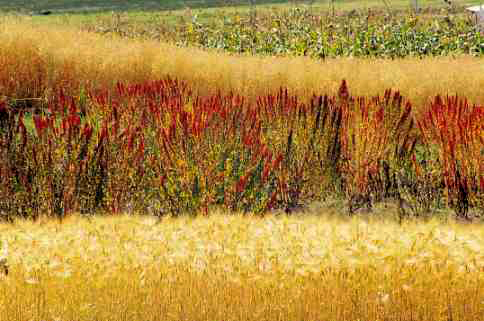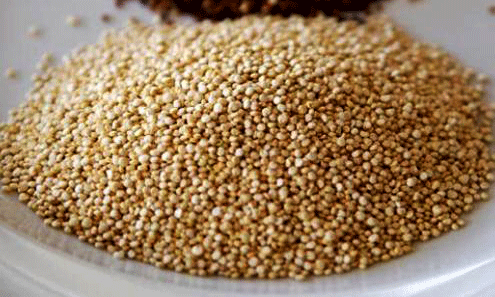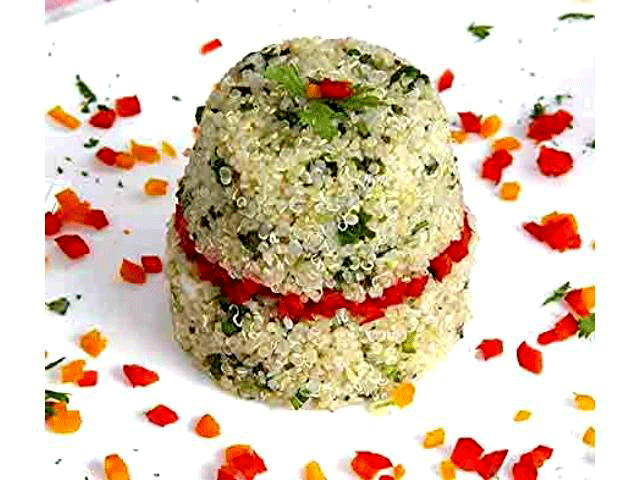The History of Quinoa
Quinoa (Chenopodium quinoa), which is known as "Quinoa” is an ancient food crop from the Andean area. Some findings indicate that its cultivation dates back to 5000 BC and it was used as food around 3000 BC. These dates are confirmed by the archaeological data available.
Quinoa was considered by the Inca Empire as a sacred food, besides being used for multiple uses as food, soap (thanks to the saponin) and medicine, according to some historians. Quinoa was used to prepare meals such as cookies, porridges etc.
Spanish: Quinoa, Quinoa, Quinque, Kino, Triguillo, Wheat Inca Arrocillo, Rice Peru.
Cultivation of Quinoa
Currently this grain is grown in many parts of Latin America from Peru to Bolivia, Ecuador, Chile, Colombia and Argentina.
Quinoa can be classified based on certain characteristics such as its size (large, medium and small) and color (white, brown, yellow, gray, pink, red and black).
In regard to its cultivation, it is usually performed between 3000 and 4000 m.
Quinoa is a plant which is grown anually and takes about 150 to 240 days to reach maturity. Since this plant is grown at high altitudes it is exposed to frost during growth and the plant is well adapted to different environmental conditions.
|
Quinoa: Wash and desaponification
The saponin content of quinoa grains are responsible for the original bitter taste and can be used as soap. You need to remove the saponins to be able to consume this grain.
Removal methods include: manual (friction with the hands and water) or industrial (scarification, dry cleaning and washing methods combined drying and moistening).
Nutritional value and properties of Quinoa
Quinoa has been one of the most basic foods of ancient populations.
Today it still maintains this reputation because thanks to scientific analysis, it has been confirmed the real value of the Quinoa and high nutrient in comparison with other cereals such as wheat, barley, rice, maize (see Table 1).
Table 1. Average composition of the nutritional value of quinoa grains
Component Average
|
Average
|
Moisture
|
12,65 |
Fat
|
5,01 |
Protein
|
13,81 |
Ash
|
3,36 |
Carbohydrates
|
59,74 |
Celullose
|
4,38 |
Fibre
|
4,14 |
Quinoa is a plant source of protein, not so much because of its quantity but its quality, which gives it high biological value.
The quality of proteins depends on the composition of amino acids, especially the amount of essential amino acids. Thus, lysine, one of the few essential amino acids in plant foods is present in Quinoa in proportions that are almost double those in other cereals.
Quinoa contains a relatively high percentage of minerals, among which potassium and phosphorus.
Table 2. Essential amino acids in Quinoa (Ewart 1967)
Amino acid |
(*)g/10 kg. Gross
|
Isoleucine
|
68 |
Leucine
|
104 |
Lysine
|
79 |
Phenylalanin
|
79 |
Tyrosine
|
41 |
Cystine
|
Methionine
|
Metionina |
18 |
Treonine
|
40 |
Tryptofan
|
16 |
Valine
|
76 |
Table 3. Quinoa Vitamins
Vitamins
|
(mgr./100 g)
|
Vit. A |
0,36 (variety 1) 0,12 (variety 2) |
Vit. B Tiamina |
0,51 |
Riboflavin |
0,39 |
Niacin
|
1,2 |
Vit. C Acid |
6,24 |
In addition to the content of amino acids and vitamins (see table 2 and 3), Bruin (op. cit) found a high amount of vitamin E, which allows Quinoa to be considered an important source of vitamins.
The nutritional content of quinoa, makes it an excellent food for both children and adults.
Uses :
Traditionally quinoa grains are roasted and can be converted into flour. They can be  boiled, added to soups, used as cereal, pasta and even fermented for beer or chicha, which is considered the drink of the Incas. When cooked, it has a nutty flavor. Quinoa flour is produced and sold in Peru and Bolivia, often replacing wheat flour and its derivatives enriches bread, cakes andcookies. Mixing quinoa with corn, wheat, barley or potato produces nutritious food and an appetizing meal for malnourished children in Peru and Bolivia. The plant is sometimes used as a vegetable, and its leaves are eaten fresh or cooked. It is used to feed animals such as alpacas, llamas, cattle, donkey, sheep and guinea pigs. Its grains and roots are excellent food for poultry and pigs. boiled, added to soups, used as cereal, pasta and even fermented for beer or chicha, which is considered the drink of the Incas. When cooked, it has a nutty flavor. Quinoa flour is produced and sold in Peru and Bolivia, often replacing wheat flour and its derivatives enriches bread, cakes andcookies. Mixing quinoa with corn, wheat, barley or potato produces nutritious food and an appetizing meal for malnourished children in Peru and Bolivia. The plant is sometimes used as a vegetable, and its leaves are eaten fresh or cooked. It is used to feed animals such as alpacas, llamas, cattle, donkey, sheep and guinea pigs. Its grains and roots are excellent food for poultry and pigs.
.
Nutrition:
Quinoa has an exceptional balance of protein, fat, oil and starch. The protein content is  high because the embryo is a large part of the seed. The average grain protein is 16%, but quinoa can contain up to 23%, more, that is double than any other cereal. Additionally the proteins in quinoa are close to the recommended rate dictated by the FAO for human nutrition. Quinoa proteins have a high degree of amino acid, lysine, methionineand cystine. The seeds contain between 58 and 68% starch and 5% sugar, although the starch grains are quite small, they contain about 20% amylose and form gels from 55 to 65 ° C. The fat content is between 4 and 9%, of which half contains linoleic acid, essential for the human diet. It Contains high levels of calcium and phosphorus. The concentrated nutrients from the leaves have a low rate of nitrate and oxalate, which are considered harmful elements in nutrition. high because the embryo is a large part of the seed. The average grain protein is 16%, but quinoa can contain up to 23%, more, that is double than any other cereal. Additionally the proteins in quinoa are close to the recommended rate dictated by the FAO for human nutrition. Quinoa proteins have a high degree of amino acid, lysine, methionineand cystine. The seeds contain between 58 and 68% starch and 5% sugar, although the starch grains are quite small, they contain about 20% amylose and form gels from 55 to 65 ° C. The fat content is between 4 and 9%, of which half contains linoleic acid, essential for the human diet. It Contains high levels of calcium and phosphorus. The concentrated nutrients from the leaves have a low rate of nitrate and oxalate, which are considered harmful elements in nutrition.
|